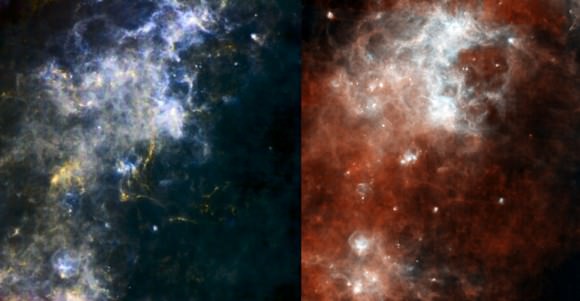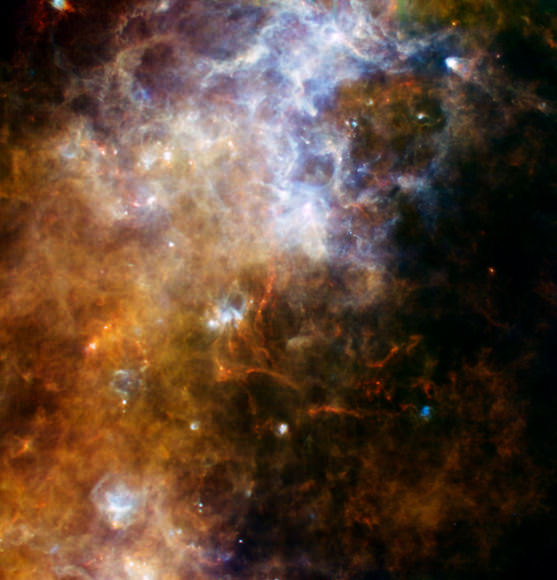[/caption]
Science observations have begun in earnest for the Herschel Space Telescope, and this spectacular image is the first produced by combining data from two cameras aboard Herschel, the Spectral and Photometric Imaging REceiver (SPIRE), and the Photoconductor Array Camera and Spectrometer (PACS). It shows a tumultuous region in the Southern Cross, visible only because the instruments are tuned to “see” in five different infrared wavelengths. Stunning vistas of cold gas clouds lying near the plane of the Milky Way reveal intense, unexpected activity. The dark, cool region is dotted with stellar factories, like pearls on a cosmic string.
Herschel, one of the largest telescopes in space, was launched in May. For this image, the two instruments were aimed at an area in the plane of the Milky Way about 60° from its center. It covers around 16 times the area of the Full Moon as seen in the sky.
The images were taken on September 3, 2009 during the first trial run with the two instruments working together. Herschel will go on to survey large areas of our galaxy.

The five original infrared wavelengths have been color-coded to allow scientists to differentiate extremely cold material (red) from the surrounding, slightly warmer stuff (blue).
The images reveal structure in cold material in our Galaxy, as we have never seen it before, and even before a detailed analysis, scientists have gleaned information on the quantity of the material, its mass, temperature, composition and whether it is collapsing to form new stars.
Beautiful evidence that our galaxy keeps giving birth to new generations of stars!
Source: ESA


I think I’m going to like Herschel images a lot, these cold-toned palettes are gorgeous!
I wonder however, are the images on the ESA website actually hi-res? There seems to be lots of artefacts.
Echoing Manu’s comments above, the ESA website offers only lossy compressed JPEG images. Are no lossless compression images available (say TIFF or FITS files)? Also, no detailed info is given as to the exact coordinates of the image presented. How about more detailed info and images from ESA?
[blockquote]The dark, cool region is dotted with stellar factories[/blockquote]
The biggest dark cool region I know of in Crux is the Coal Sack Nebula- which for some bizzare reason, even though it is one of the most prominent dark nebulae, does not have an NGC number. The Coalsack nebula also fits with the description of ‘near the galactic plane’ (it’s only visible in optical wavelengths because it’s shillouetted by the milkyway itself.
High res versions available here:
http://sci.esa.int/science-e/www/object/index.cfm?fobjectid=45626&fareaid=16
Still looking for more information about where precisely the images were taken.
@Trippy, Thanks for your earlier posts on the exact location of the Herschel images. I agree that this is most likely located within the Coal Sack, but precisely where. The ESA caption notes that the field of view is 2 degrees square, much smaller than the extent of the Coal Sack. I’m curios as to the exact location in order to produce multispectral images of this area (somewhere in the Coal Sack?). Guess its back to 2MASS and other relevant IR surveys to flesh out its location. Thanks again for trying to track down data on these images, as I will do likewise 🙂
P.S. I still wish the ESA will publish higher resolution lossless images from Herschel at some time in the mission. I realize these are early test & calibration images, so hopefully full-res TIFF (or FITS) formats will soon be available. ‘JPEG okay, TIFF better’.
It’s a beautiful Cold Plasma, not Gas.
Prime
Exactly how cold is this ‘Cold Plasma’? Is it warm enough to support Cold Fusion? 🙂
I think I read somewhere that this cold plasma has about 10K. If cold fusion should ever work, then there 😀
@John Hanford:
I emailed Proff Mat Griffin, who was listed as a contact for this article as it was published on the Cardiff University website, and he said that at this time the ESA simply aren’t releasing the information about exactly where the image is centered so it’s not simply a case of knowing where to look on the ESA website).
I imagine that’s because, you say, these images represent the callibration phase, and so they’re trying to avoid people doing science with the data (which wouldalso explain the apparent lack of high res lossless images).
Nice images, and it illustrates how our galaxy, the oldest we see in the universe, is still a dynamics star factory.
LC
Thanks again, Trippy, for trying to track down info about these images. Perhaps when instrumental calibration is complete, these images will appear again in a published paper along with an in depth analysis. Until then, I can enjoy some great images of star forming regions hidden in the dust and gas of the Coal Sack.
A stunning image… Herschel is an awesome achievement!
I want to see more! Yummy….